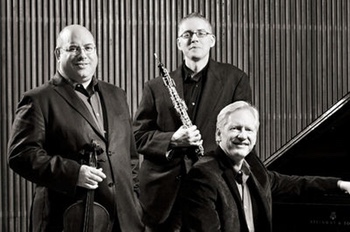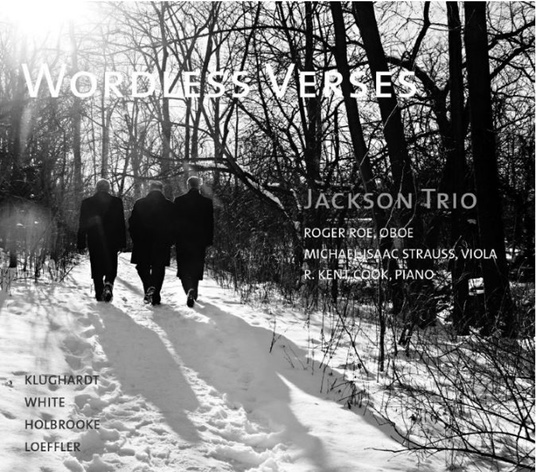Wordless Verses (Naxos)
The Jackson Trio
Oboe, viola and piano may seem an unlikely combination, but there’s no reason why it should. Individually, they have totally different voices, but they combine in any number of enticing ways. This recording provides ample evidence to support of that.
At times, the oboe is bright and chipper while the viola is somewhat restrained and somber without being morose. The piano plays the part of the shepherd: watchful, keeping the other two together, while occasionally going off on its own exploration. Taken as a whole, it’s a winning combination.
Happily, the music chosen for this recording allows each man his own time in the spotlight, with myriad opportunities for ensemble music-making of the highest caliber. Although all of the selections are based on literary works, only one of them was ever intended to be sung.
It’s interesting to hear newer — or at least previously unknown — but deeply romantic music for the first time, a century or more after it was born. By deeply romantic I mean music written between 1872 and 1921. Three of the four tracks are from the early 20th century, but lean back to the romantic era. Two of the composers are German; two are English.
The earliest piece is by Five Fantasy Pieces by August Klughardt, who was influenced by Wagner and Liszt. The poetry is by Nicholas Lenau, also a devotee of Liszt and Richard Strauss. This is lyrical music, with long lovely lines, in which one can almost hear the singing. The oboe and viola complement each other without becoming entangled with themselves or the piano.
The newest work, by Felix Harold White, dates to 1921, while using the oldest of the source poems, The Nymph’s Complaint for the Death of her Fawn, written by 17th-century poet Andrew Marvell. Don’t be distracted by the love-duet between the oboe and the viola – it fades into nothing, all too soon.
Another English composer Josef Holbrooke was obsessed by the works of American poet Edgar Allen Poe and wrote several pieces as inspired by the poems. The one here is titled the 1917 Nocturne — Fairyland. The music is like the poetry: eccentric, enchanting and esoteric. Stacked chords at the beginning and end of the piece tie it all together very nicely.
The last suite, Deux Rhapsodies from 1901, is the most American-sounding piece on the disk even though composer Charles Martin Loeffler was born in Germany and raised in France. He settled in Boston at 20, where his career took off. He was for many years a violinist in the Boston Symphony and is primarily known for his large, colorful orchestral compositions.
The first movement L’Étang (The Pond) was more or less a tribute to a friend who perished when ocean liner La Bourgogne sank in 1898. It is replete with variations on the Dies Irae. The melodies interweave with each other and are jaunty at times, until closer to the ending, when the melancholy theme by the oboe is brought up to a major key by the viola.
The second rhapsody, La Cornemuse (The Pipes) was dedicated to oboist Georges Longy, who played at the 1901 premiere. At times, the instruments are in harmony with each other, while at others, they seem to go off in totally opposite directions, reminiscent of bagpipes.
The Jackson Trio has been together for a while, but this is their first recording. All three musicians have ties to both Northeast Ohio and Indiana. Oboist Roger Roe, a Texas native, graduated from the Cleveland Institute of Music where he studied with John Mack. Pianist R. Kent Cook, also from Texas, has appeared at CSU and Oberlin. Violist Michael Isaac Strauss was principal violist of the Indianapolis Symphony for 20 years, where Mr. Roe was assistant principal oboe and English horn, also for 20 years.
Find out more here.
[Written by Kelly Ferjutz]

